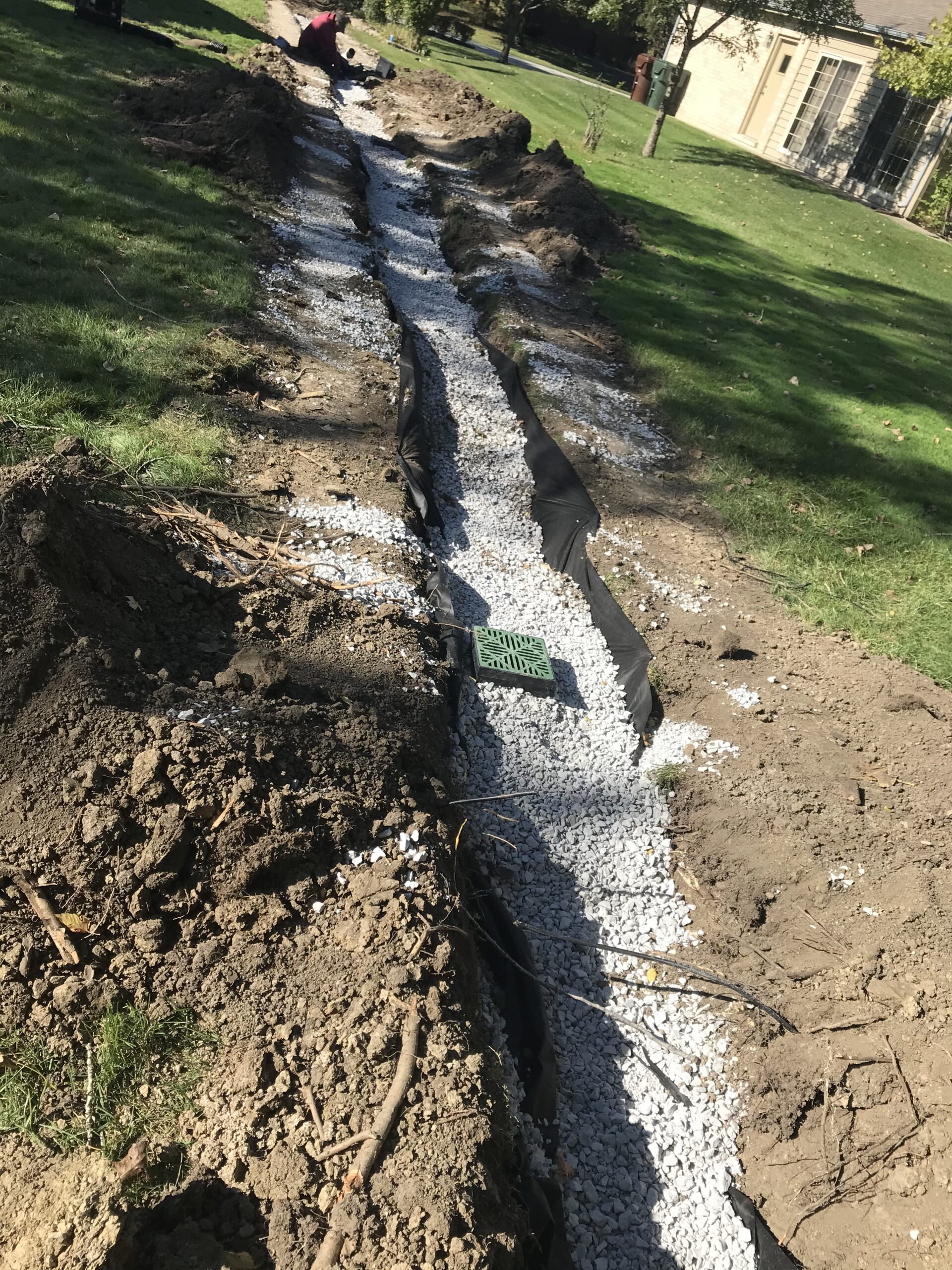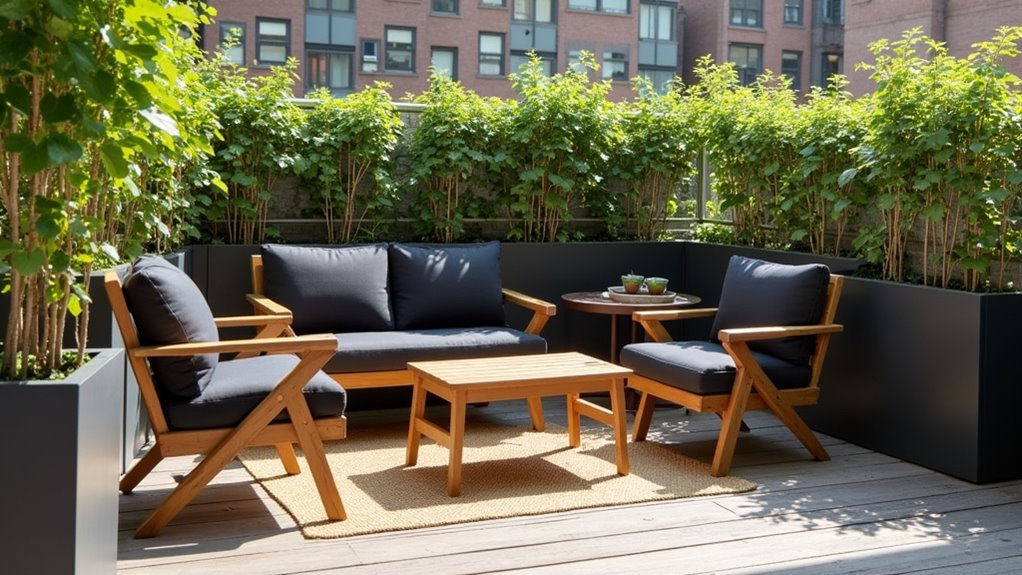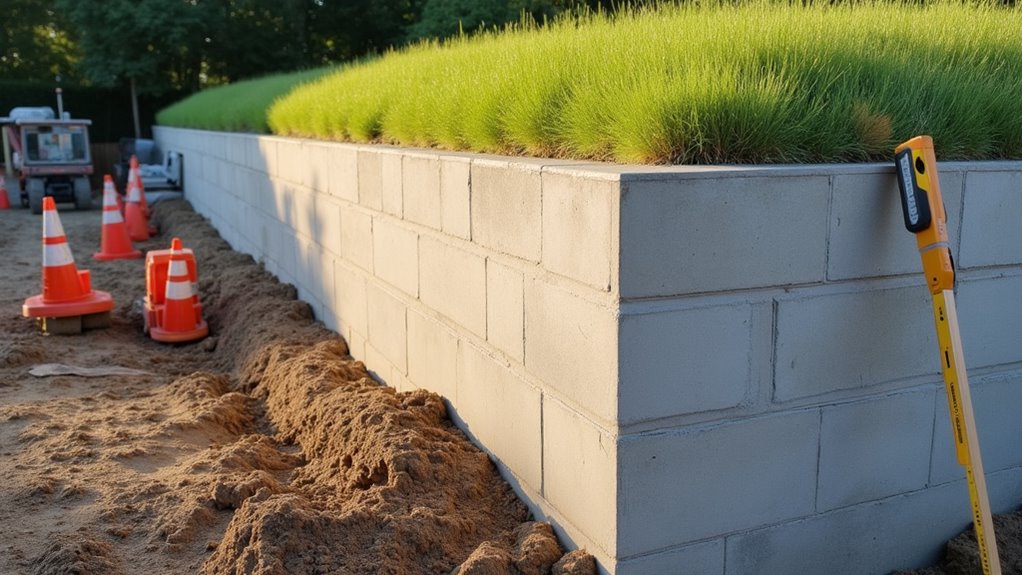Yard grading refers to how your property’s ground slopes and directs water flow away from your home’s foundation. You’ll want your yard to slope away from your foundation at a rate of 6 inches for every 10 horizontal feet to prevent water damage and structural issues. Poor grading can lead to basement moisture, soil erosion, and costly foundation repairs. While you can measure your yard’s slope with basic tools, complex grading often requires professional expertise to guarantee proper drainage and long-term protection.
The Basics of Proper Yard Grading

While many homeowners focus on landscaping aesthetics, proper yard grading forms the foundation of a functional outdoor space. You’ll need to understand how water flows across your property to implement effective grading techniques. The ideal grade slopes away from your home’s foundation at a rate of 6 inches for every 10 horizontal feet.
To achieve proper drainage solutions, start by identifying low spots where water pools and high areas that direct runoff in the direction of your home. You’ll want to create a gentle slope that channels water away from structures and in the direction of appropriate drainage points. This might include installing French drains, catch basins, or swales. Consider soil composition and compaction rates when adjusting grade levels, as these factors greatly impact how well your yard handles water flow.
Signs Your Property Has Grading Issues
 Understanding the difference between proper and improper yard grading starts with recognizing key warning signs on your property. If you notice water pooling near your foundation after rainfall, or your basement experiences frequent moisture issues, you’re likely facing drainage problems. Watch for soil erosion along your property’s slopes and areas where mulch or topsoil consistently washes away.
Understanding the difference between proper and improper yard grading starts with recognizing key warning signs on your property. If you notice water pooling near your foundation after rainfall, or your basement experiences frequent moisture issues, you’re likely facing drainage problems. Watch for soil erosion along your property’s slopes and areas where mulch or topsoil consistently washes away.
You’ll also want to inspect your home’s exterior for signs of water damage, including stained siding, cracked foundation walls, or mildew growth. Pay attention to standing water that remains in your yard for more than 24 hours after precipitation ends. Other indicators include uneven grass growth, exposed tree roots, and soil that’s consistently muddy or compacted. These issues often signal the need for professional grading assessment and correction.
How Yard Grading Affects Your Home’s Foundation

Proper yard grading serves as your home’s primary line of defense against foundation damage. When your yard slopes correctly away from your foundation, it directs water flow away from your home’s structural base, ensuring drainage efficiency and preventing soil erosion around the foundation walls.
Poor grading can compromise your foundation stability in several ways. If water pools near your foundation, it can seep into basement walls, create hydrostatic pressure, and cause the soil to expand and contract. This cycle weakens your foundation over time, potentially leading to cracks, settling, and structural shifts. In areas with expansive clay soils, improper grading becomes even more critical, as water-saturated soil can exert significant pressure on foundation walls. You’ll need at least a 6-inch drop in grade over the primary 10 feet extending from your foundation.
DIY Guide to Measuring Your Yard’s Slope
Measuring your yard’s slope accurately requires just a few common tools and basic math skills. You’ll need a 2×4 board, a level, and a tape measure to get started. Place the board’s end on the ground at your home’s foundation, and extend it towards the area you’re measuring. Rest your level on the board and adjust until it’s perfectly horizontal.
For precise slope measurement, measure the vertical distance from the board’s raised end to the ground, then measure the horizontal distance from your foundation to where the board ends. Divide the vertical measurement by the horizontal distance and multiply by 100 to get your percentage grade. For proper yard leveling, you’ll want at least a 2% grade moving away from your foundation, ensuring water flows away from your house.
Professional Grading Solutions and Cost Considerations
While DIY grading can save money, complex yard leveling often requires professional expertise and specialized equipment. You’ll want to contact multiple grading contractors for detailed cost estimates, which typically range from $1,000 to $5,000 depending on your yard’s size and complexity.
Professional grading solutions include laser leveling, excavation with heavy machinery, and engineered drainage systems. You’ll benefit from contractors’ knowledge of local soil conditions, water flow patterns, and building codes. They’ll also guarantee proper slope calculations, usually maintaining a 2-6% grade away from your home’s foundation.
When evaluating estimates, consider factors like soil removal, material costs, equipment rental, and labor. Many contractors offer extensive packages that include soil testing, permits, and post-grading landscaping restoration. Request written warranties and verify their insurance coverage before proceeding.
Frequently Asked Questions
How Long Does a Properly Graded Yard Typically Last Before Needing Maintenance?
Your properly graded yard‘s longevity typically lasts 5-10 years before requiring maintenance, though this varies based on several factors. You’ll notice shorter intervals if you’re dealing with heavy rainfall, poor soil composition, or extensive landscaping changes. To enhance grading techniques’ effectiveness, you’ll want to conduct annual inspections, address erosion promptly, and maintain proper drainage systems. Climate conditions and soil type greatly impact how long your grading work remains effective.
Can Yard Grading Affect the Growth of Certain Plants and Trees?
Yes, yard grading greatly impacts plant growth through its effect on soil drainage and water distribution. When you’ve got proper grading, water flows efficiently, allowing roots to access necessary moisture without becoming waterlogged. Poor grading can create dry spots or oversaturated areas that stunt plant development. You’ll notice some plants thrive in well-graded slopes while others prefer flat terrain. It’s essential to take into account your environment’s grade when selecting plants for different areas.
Does Homeowners Insurance Typically Cover Damage Caused by Improper Yard Grading?
Your standard homeowner’s insurance typically won’t cover damage caused by improper yard grading, as it’s considered a maintenance issue rather than a sudden, accidental event. Most policies exclude problems resulting from poor drainage or grading liability. You’ll need to address grading issues proactively, as insurance coverage generally only applies to unexpected water damage from burst pipes or sudden flooding, not gradual damage from improper terrain slopes.
What Permits Are Required for Major Yard Grading Projects?
You’ll need to check your local regulations since grading permit requirements vary by municipality. Typically, you’ll require permits for major grading projects that involve moving more than 50 cubic yards of soil or changing the property’s drainage patterns. Contact your city’s building department or planning office to determine specific requirements. They’ll likely want to review your grading plans, erosion control measures, and potential impact on neighboring properties before issuing permits.
How Does Seasonal Freeze-Thaw Cycles Impact Yard Grading Effectiveness?
Freeze-thaw effects can greatly compromise your yard’s grading over time. As soil repeatedly expands when frozen and contracts when thawed, you’ll notice shifts in ground elevation and potential drainage issues. To combat these cycles, you’ll need specialized grading techniques like deeper soil compaction and frost-resistant materials. Installing proper drainage systems and maintaining a slight slope away from structures year-round will help preserve your grading work through seasonal temperature fluctuations.



